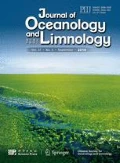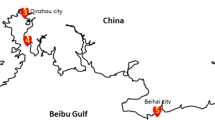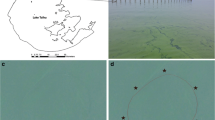Abstract
Harmful cyanobacterial blooms cause many ecological disasters worldwide. During the development of cyanobacterial blooms, the diversity and domination of cyanobacterial taxa are of a particular concern. In this study, the microbial community structure within a water system, such as in Yuqiao Reservoir and Haihe River in Tianjin City, China, was compared by using next-generation sequencing. A total of 5 001 operational taxonomic units were obtained and clustered from filtered 16S rDNA V3–V4 region sequences. The cyanobacterial and microbial structures greatly differed in these two water areas. Microcystis was dominant in Yuqiao, whereas Synechococcus was dominant in Haihe. Proteobacteria species were dominant among all detected samples. The relative abundances of Bacteroidetes and Planctomycetes were higher in Yuqiao Reservoir than in Haihe River, whereas Firmicutes and Verrucomicrobia were relatively abundant in Haihe River. Further analyses indicated that the domination of both cyanobacteria was strongly related to several environmental factors, such as total nitrogen, total phosphorus, and dissolved oxygen, reflecting the role of trophic states in shaping the dominance of cyanobacterial taxa. The present study provided the example for Microcystis and Synechococcus dominance along a cyanobacterial bloom in north China. Applying highthroughput sequencing could offer a wide field of vision in analyzing microbial community structures.
Similar content being viewed by others
References
Bertos-Fortis M, Farnelid H M, Lindh M V, Casini M, Andersson A, Pinhassi J, Legrand C. 2016. Unscrambling cyanobacteria community dynamics related to environmental factors. Front iers in Microbiology, 7: 625.
Bozarth C S, Schwartz A D, Shepardson J W, Colwell F S, Dreher T W. 2010. Population turnover in a Microcystis bloom results in predominantly nontoxigenic variants late in the season. Applied and Environmental Microbiology, 76 (15): 5 207–5 213.
Briand E, Escoffier N, Straub C, Sabart M, Quiblier C, Humbert J F. 2009. Spatiotemporal changes in the genetic diversity of a bloom-forming Microcystis aeruginosa (cyanobacteria) population. The ISME Journal, 3 (4): 419–429.
Brunberg A K. 1999. Contribution of bacteria in the mucilage of Microcystis spp. (Cyanobacteria) to benthic and pelagic bacterial production in a hypereutrophic lake. FEMS Microbiology Ecology, 29 (1): 13–22.
Cai H Y, Yan Z S, Wang A J, Krumholz L R, Jiang H L. 2013. Analysis of the attached microbial community on mucilaginous cyanobacterial aggregates in the eutrophic Lake Taihu reveals the importance of Planctomycetes. Microbial Ecology, 66 (1): 73–83.
Cai Y F, Kong F X. 2013. Diversity and dynamics of picocyanobacteria and the bloom-forming cyanobacteria in a large shallow eutrophic lake (Lake Chaohu, China). Journal of Limnology, 72 (3): 473–484.
Caporaso J G, Kuczynski J, Stombaugh J, Bittinger K, Bushman F D, Costello E K, Fierer N, Peña A G, Goodrich J K, Gordon J I, Huttley G A, Kelley S T, Knights D, Koenig J E, Ley R E, Lozupone C A, McDonald D, Muegge B D, Pirrung M, Reeder J, Sevinsky J R, Turnbaugh P J, Walters W A, Widmann J, Yatsunenko T, Zaneveld J, Knight R. 2010. QIIME allows analysis of high-throughput community sequencing data. Nat ure Methods, 7 (5): 335–336.
Carvalho G, Lemos P C, Oehmen A, Reis M A M. 2007. Denitrifying phosphorus removal: linking the process performance with the microbial community structure. Water Research, 41 (19): 4 383–4 396.
Chen C, Zhang Z C, Ding A Z, Wu J Y, Xiao J F, Sun Y J. 2011. Bar-coded pyrosequencing reveals the bacterial community during Microcystis water bloom in Guanting reservoir, Beijing. Procedia Engineering, 18: 341–346.
Dixon P. 2003. VEGAN, a package of r functions for community ecology. Journal of Vegetation Science, 14 (6): 927–930.
Edgar R C. 2010. Search and clustering orders of magnitude faster than BLAST. Bioinformatics, 26 (19): 2 460–2 461.
Eiler A, Bertilsson S. 2004. Composition of freshwater bacterial communities associated with cyanobacterial blooms in four Swedish lakes. Environmental Microbiology, 6 (12): 1 228–1 243.
Fleming L E, Rivero C, Burns J, Williams C, Bean J A, Shea K A, Stinn J. 2002. Blue green algal (cyanobacterial) toxins, surface drinking water, and liver cancer in Florida. Harmful Algae, 1 (2): 157–168.
Grob C, Ulloa O, Li W K W, Alarcón G, Fukasawa M, Watanabe S. 2007. Picoplankton abundance and biomass across the eastern South Pacific Ocean along latitude 32.5°S. Marine Ecology Progress Series, 332: 53–62.
Harke M J, Steffen M M, Gobler C J, Otten T G, Wilhelm S W, Wood S A, Paerl H W. 2016. A review of the global ecology, genomics, and biogeography of the toxic cyanobacterium, Microcystis spp. Harmful Algae, 54: 4–20.
Harvey T S. 2012. Cyanobacteria blooms: Maya peoples between the politics of risk and the threat of disaster. Medical Anthropology, 31 (6): 477–496.
Herlemann D P, Labrenz M, Jürgens K, Bertilsson S, Waniek J J, Andersson A F. 2011. Transitions in bacterial communities along the 2 000 km salinity gradient of the Baltic Sea. The ISME J ourna l, 5 (10): 1 571–1 579.
Hu M M, Li Y H, Wang Y C, Zhou H D, Liu Y D, Zhao G F. 2013. Phytoplankton and bacterioplankton abundances and community dynamics in Lake Erhai. Water Sci ence & Technology, 68 (2): 348–356.
Javůrek J, Sychrová E, Smutná M, Bittner M, Kohoutek J, Adamovský O, Nováková K, Smetanová S, Hilscherová K. 2015. Retinoid compounds associated with water blooms dominated by Microcystis species. Harmful Algae, 47: 116–125.
Jiang Y G, Xiao P, Liu Y, Wang J X, Li R H. 2017. Targeted deep sequencing reveals high diversity and variable dominance of bloom-forming cyanobacteria in eutrophic lakes. Harmful Algae, 64: 42–50.
Klawonn I, Bonaglia S, Brüchert V, Ploug H. 2015. Aerobic and anaerobic nitrogen transformation processes in N 2-fixing cyanobacterial aggregates. The ISME Journal, 9 (6): 1 456–1 466.
Kong P, Richardson P, Hong C X. 2017. Diversity and community structure of cyanobacteria and other microbes in recycling irrigation reservoirs. PLoS One, 12 (3): e0173903.
Lee J Z, Burow L C, Woebken D, Everroad R C, Kubo M D, Spormann A M, Weber P K, Pett-Ridge J, Bebout B M, Hoehler T M. 2014. Fermentation couples Chloroflexi and sulfate-reducing bacteria to Cyanobacteria in hypersaline microbial mats. Frontiers in Microbiology, 5: 61.
Li W K W. 1998. Annual average abundance of heterotrophic bacteria and Synechococcus in surface ocean waters. Limnology and Oceanography, 43 (7): 1 746–1 753.
Li X C, Li S C, Kong R Q, Li R H. 2016. Molecular separation of two long taxonomically debated cyanobacterial genera Cylindrospermopsis and Raphidiopsis (Nostocales) based on the ITS-L phylogeny. Harmful Algae, 57: 88–97.
Li Z H, Lin S Q, Liu X L, Tan J, Pan J L, Yang H. 2014. A freshwater bacterial strain, Shewanella sp. Lzh–2, isolated from Lake Taihu and its two algicidal active substances, hexahydropyrrolo[1,2–a]pyrazine–1,4–dione and 2,3–indolinedione. Applied Microbiology and Biotechnology, 98 (10): 4 737–4 748.
Liu X S, Shi C F, Xu X G, Li X J, Xu Y, Huang H Y, Zhao Y P, Zhou Y W, Shen H C, Chen C, Wang G X. 2017. Spatial distributions of β-cyclocitral and β-ionone in the sediment and overlying water of the west shore of Taihu Lake. Science of the Total Environment, 579: 430–438.
Lone Y, Koiri R K, Bhide M. 2015. An overview of the toxic effect of potential human carcinogen Microcystin-LR on testis. Toxicology Reports, 2: 289–296.
Martin M. 2011. Cutadapt removes adapter sequences from high-throughput sequencing reads. EMBnet Journal, 17 (1): 10–12.
Maruyama T, Kato K, Yokoyama A, Tanaka T, Hiraishi A, Park H D. 2003. Dynamics of microcystin-degrading bacteria in mucilage of Microcystis. Microbial Ecology, 46 (2): 279–288.
Moll D M, Summers R S, Fonseca A C, Matheis W. 1999. Impact of temperature on drinking water biofilter performance and microbial community structure. Environmental Science & Technology, 33 (14): 2 377–2 382.
O'Neil J M, Davis T W, Burford M A, Gobler C J. 2012. The rise of harmful cyanobacteria blooms: the potential roles of eutrophication and climate change. Harmful Algae, 14: 313–334.
Paerl H W, Huisman J. 2008. Blooms like it hot. Science, 320 (5872): 57–58.
Palíková M, Krejčí R, Hilscherová K, Babica P, Navrátil S, Kopp R, Bláha L. 2007. Effect of different cyanobacterial biomasses and their fractions with variable microcystin content on embryonal development of carp (Cyprinus carpio L.). Aquatic Toxicology, 81 (3): 312–318.
Parulekar N N, Kolekar P, Jenkins A, Kleiven S, Utkilen H, Johansen A, Sawant S, Kulkarni-Kale U, Kale M, Saebø M. 2017. Characterization of bacterial community associated with phytoplankton bloom in a eutrophic lake in South Norway using 16S rRNA gene amplicon sequence analysis. PLoS One, 12 (3): e0173408.
Parveen B, Ravet V, Djediat C, Mary I, Quiblier C, Debroas D, Humbert J F. 2013. Bacterial communities associated with Microcystis colonies differ from free-living communities living in the same ecosystem. Environmental Microbiology Reports, 5 (5): 716–724.
Post A F, Penno S, Zandbank K, Paytan A, Huse S M, Welch D M. 2011. Long term seasonal dynamics of Synechococcus population structure in the Gulf of Aqaba, Northern Red Sea. Frontiers in Microbiology, 2: 131.
Robles Aguilar A A, Grunert O, Boon N, Temperton V, Blossfeld S, Hernandez-sanabria E, Reheul D, Jablonowski N D. 2015. Microbial community structure in the rhizosphere of narrow-leafed lupin and tomato as related to nitrogen form provided. FZJ-2015-06132.
Romo S, Soria J, Fernández F, Ouahid Y, Barón-Solá Á. 2013. Water residence time and the dynamics of toxic cyanobacteria. Freshwater Biology, 58 (3): 513–522.
Ruber J, Bauer F R, Millard A D, Raeder U, Geist J, Zwirglmaier K. 2016. Synechococcus diversity along a trophic gradient in the Osterseen Lake District, Bavaria. Microbiology, 162 (12): 2 053–2 063.
Schloss P D, Westcott S L, Ryabin T, Hall J R, Hartmann M, Hollister E B, Lesniewski R A, Oakley B B, Parks D H, Robinson C J, Sahl J W, Stres B, Thallinger G G, Van Horn D J, Weber C F. 2009. Introducing mothur: opensource, platform-independent, community-supported software for describing and comparing microbial communities. Applied and Environmental Microbiology, 75 (23): 7 537–7 541.
Schmieder R, Edwards R. 2011. Quality control and preprocessing of metagenomic datasets. Bioinformatics, 27 (6): 863–864.
Shen H, Niu Y, Xie P, Tao M, Yang X. 2011. Morphological and physiological changes in Microcystis aeruginosa as a result of interactions with heterotrophic bacteria. Freshwater Biology, 56 (6): 1 065–1 080.
Shi L M, Cai Y F, Kong F X, Yu Y. 2012. Specific association between bacteria and buoyant Microcystis colonies compared with other bulk bacterial communities in the eutrophic Lake Taihu, China. Environmental Microbiology Reports, 4 (6): 669–678.
Shi L M, Cai Y F, Wang X Y, Li P F, Yu Y, Kong F X. 2010. Community structure of bacteria associated with Microcystis colonies from cyanobacterial blooms. Journal of Freshwater Ecology, 25 (2): 193–203.
Sinang S C, Reichwaldt E S, Ghadouani A. 2013. Spatial and temporal variability in the relationship between cyanobacterial biomass and microcystins. Environmental Monitoring and Assessment, 185 (8): 6 379–6 395.
Stadler L B, Love N G. 2016. Impact of microbial physiology and microbial community structure on pharmaceutical fate driven by dissolved oxygen concentration in nitrifying bioreactors. Water Research, 104: 189–199.
Stuart R K, Mayali X, Lee J Z, Everroad R C, Hwang M, Bebout B M, Weber P K, Pett-Ridge J, Thelen M P. 2016. Cyanobacterial reuse of extracellular organic carbon in microbial mats. The ISME Journal, 10 (5): 1 240–1 251.
Takasu H, Ushio M, LeClair J E, Nakano S I. 2015. High contribution of Synechococcus to phytoplankton biomass in the aphotic hypolimnion in a deep freshwater lake (Lake Biwa, Japan). Aquatic Microbial Ecology, 75 (1): 69–79.
Verspagen J M H, Van de Waal D B, Finke J F, Visser P M, Van Donk E, Huisman J. 2014. Rising CO2 levels will intensify phytoplankton blooms in eutrophic and hypertrophic lakes. PLoS One, 9 (8): e104325.
Vincent W F, Castenholz R W, Downes M T, Howard-williams C. 1993. Antarctic cyanobacteria: light, nutrients, and photosynthesis in the microbial mat environment. Journal of Phycology, 29 (6): 745–755.
Visser P M, Verspagen J M H, Sandrini G, Stal L J, Matthijs H C P, Davis T W, Paerl H W, Huisman J. 2016. How rising CO2 and global warming may stimulate harmful cyanobacterial blooms. Harmful Algae, 54: 145–159.
Wegener D, Sengstag T, Sfakianakis S, Rüping S, Assi A. 2009. GridR: an R-based tool for scientific data analysis in grid environments. Future Generation Computer Systems, 25 (4): 481–488.
Wickham H. 2016. ggplot2: Elegant Graphics for Data Analysis. 2 nd edn. Springer, Heidelberg. p.180–185.
Wirsing B, Hoffmann L, Heinze R, Klein D, Daloze D, Braekman J C, Weckesser J. 1998. First report on the identification of microcystin in a water bloom collected in Belgium. Systematic and Applied Microbiology, 21 (1): 23–27.
Wu S K, Xie P, Liang G D, Wang S B, Liang X M. 2006. Relationships between microcystins and environmental parameters in 30 subtropical shallow lakes along the Yangtze River, China. Freshwater Biology, 51 (12): 2 309–2 319.
Xie M L, Ren M L, Yang C, Yi H S, Li Z, Li T, Zhao J D. 2016. Metagenomic analysis reveals symbiotic relationship among bacteria in Microcystis-dominated community. Frontiers in Microbiology, 7: 56.
Ye W J, Tan J, Liu X L, Lin S Q, Pan J L, Li D T, Yang H. 2011. Temporal variability of cyanobacterial populations in the water and sediment samples of Lake Taihu as determined by DGGE and real-time PCR. Harmful Algae, 10 (5): 472–479.
Zhang J J, Kobert K, Flouri T, Stamatakis A. 2014. PEAR: a fast and accurate Illumina Paired-End reAd mergeR. Bioinformatics, 30 (5): 614–620.
Zhang M, Zhang Y C, Yang Z, Wei L J, Yang W B, Chen C, Kong F X. 2016. Spatial and seasonal shifts in bloomforming cyanobacteria in Lake Chaohu: patterns and driving factors. Phycological Research, 64 (1): 44–55.
Zhu M L, Xu Y, Li R H. 2012. Genetic diversity of bloomforming Microcystis (Cyanobacteria) populations in a hyper-eutrophic pond in Central China. Current Microbiology, 65 (3): 219–224.
Acknowledgment
We would like to thank ZHENG Tao, JI Dongdong, QIN Yiming and LI Na at Tianjin Agricultural University for their work to sample collecting. Especially thank to Ms. CAO Qi for her support to data arrangement.
Author information
Authors and Affiliations
Corresponding authors
Additional information
Supported by the International Science & Technology Cooperation Program of China (No. 2013DFA71340) and the National Natural Science Foundation of China (No. 51779247)
Electronic supplementary material
Rights and permissions
About this article
Cite this article
Huo, D., Chen, Y., Liu, P. et al. Molecular detection of microbial communities associated with Microcystis vs Synechococcus dominated waters in Tianjin, China. J. Ocean. Limnol. 36, 1145–1156 (2018). https://doi.org/10.1007/s00343-018-7182-x
Received:
Accepted:
Published:
Issue Date:
DOI: https://doi.org/10.1007/s00343-018-7182-x




